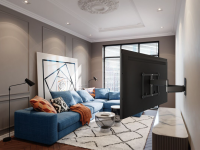No sooner had soundbars swept into our living rooms than a new range of boxes appeared on store shelves offering a different take on improving TV audio. Soundbases, as these new kids on the block are generally termed, offer benefits to both consumer and manufacturer alike, doing away with the need for a separate subwoofer that most good soundbars generally require, and giving over more space for the amplification and other important electronics inside the cabinet. That’s not to say that soundbars are old hat, more that there are alternatives out there for almost anybody to get better sound, regardless of space issues and other requirements.
Cambridge Audio saw success with their initial effort in the category, the Minx TV picking up a coveted 5-star review in What Hi-Fi at the first time of asking. Not wanting to rest on their laurels, the British marque unveiled both the Minx TV replacement, the TV2, and the model we’ll be looking at today, the TV5, at the back end of last year.
Where the original Minx TV and replacement TV2 were ideal for folks limited on space, the TV5 is given free reign to work with a bit more room. Coming in at a length of 725mm, a decent size space is needed to accommodate it, but those who can will see a fair few benefits over the smaller sized units.
Before we get to those benefits, though, let’s take a quick look at what we’re working with on the technical side of things. Cambridge have once again opted to use their Balanced Mode Radiator (BMR) drive units for this model, with one set at either edge of the front fascia. Indeed, taking the front grille off leaves the TV5 looking a bit sparse, but the drivers used here are capable of giving off such a wide and balanced frequency response that adding extra mid and high drivers / tweeters simply isn’t necessary. The subwoofer units are doubled from the TV5’s smaller brethren, offering two 165mm solely for tackling the low frequency regions.
As far as connectivity goes, the Cambridge doesn’t stray far from the pack, offering everything that every other manufacturer seemingly does these days. This certainly isn’t a gripe, as the ones included are pretty much all anybody would ever need. So alongside the ‘optical’ input you’ll find a set of RCA’s, a 3.5mm headphone-style jack, and the ever popular Bluetooth. Again, nothing ground breaking, but this is one area where playing it safe is more than allowed.
The TV5 was hooked up in our demonstration room, and the optical connection used straight into the TV. Bluetooth was also used when playing back music from a phone.
Immediately obvious when we popped in one of our go-to test discs Pacific Rim, was the extra bass the TV5 was capable of over the smaller Cambridge. The additional drive unit brought greater heft and impact to the spectacle on screen, feeling more capable of keeping up with the action. The four different equaliser modes provided (Music, Film, TV and Voice) all gave different performances, but the Film mode was easily the best for this application (as you’d expect!). Sound staging, too, was better now that the speakers were kept at a greater distance apart. It was far from unenjoyable on the TV2, but the TV5 made the sound come closer to the room boundaries, and this was the case when listening to music also.
Firing up the Bluetooth and connecting to an iPhone 4S was quick and easy. First up was Damon Albarn’s Everyday Robots, and specifically the Brian Eno-featuring Heavy Seas of Love. Eno‘s baritone intro came through clear and deep, and the excellent Albarn vocal sounded great alongside the backing choir as the chorus gets going. Performance wise, this was much more impressive than we’d maybe expected, running a more expensive mini-system and speaker package to the wire in terms of sheer musicality.
Moving back to something a bit more dialogue driven, we switched to the Freeview signal on our television to get an idea of how well the ‘TV’ equaliser mode worked. For programmes where there is little in the way of dramatic action (soaps, documentaries, etc) this particular setting helped to shore up the often wayward speech found when just using the television. Gone were the missed words and muffled background, replaced with an easy to hear, expressive sound. Again, the clarity and depth of the sound was impressive, and those looking to just improve day-to-day TV viewing would find the Cambridge well worth an audition.
Over all, we found the TV5 to be a very worthy adversary to its similarly priced rivals (namely the Tannoy Basestation One, and the Roth Neo 6.2). As with its competition, it isn’t out to replace a full Home Cinema system, but for those who still can’t get on with all the wiring involved on a such a setup, solace can be taken in the excellent sound on offer in this single box from Cambridge Audio.
Author: Chris, Liverpool store
Check out our entire soundbar range and why not pop into the store for a chat with one of our friendly advisors. You know you want to.









